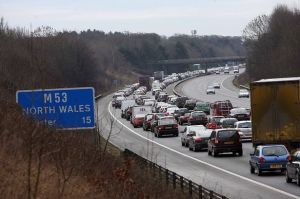THE GOVERNMENT recently announced that the M53 motorway will become a “smart” motorway.
In essence, the government are attempting to improve commuters’ journeys to and from work by increasing traffic capacity through introducing variable speed limits and opening the hard shoulder at busier times of day.
The new smart motorway will begin at junction five (A41 at Hooton) and end at junction 11 (Stoak interchange), with apparent benefits being smoother traffic flows, more reliable journey times, fewer road traffic collisions, and reduced noise and harmful vehicle emissions.
The Highways Agency cite smart motorways as ”a new technology driven approach tackling the most congested parts of our motorway network” which they say will “increase capacity, make journeys times reliable by controlling the flow and speed of traffic and provide driver information displayed on overhead signs”.
The initiative, which was announce in the Chancellor’s autumn statement, is part of an £800m road improvement scheme in the north west of England.
As someone who commutes to Chester for both university and work, this news directly affects me as a driver who uses the M53 motorway six days a week.
Upon hearing the news initially, I thought it was a bad move.
I have driven to Birmingham countless times, and the M42 is also a smart motorway. Driving through the variable speed limits during rush hour can be a nightmare, and I dread driving through Birmingham for that reason. However, four lanes are in operation, which does indeed increase traffic flow.
My issue is that I just do not feel a smart motorway is necessary for the M53.
I am not denying that smart motorways work – there are plenty of statistics on the internet by the government and the Highways Agency which support the success of the scheme. I just don’t feel like it’s going to resolve anything.
Yes, the M53 gets busy, but not to the extent where further measures need to be implemented in order to solve the problem.
After junction 5, the motorway goes down to two lanes, meaning traffic naturally feels as though it is heavier due to the bottleneck effect of the lanes.
Motorways are always going to be busy – everyone who drives on them during rush hour knows that they will more than likely get stuck in traffic of some kind.
I personally feel that the traffic into Chester can be much worse when driving via Hoole Lane.
Surely the government should be focusing on improving traffic conditions in much busier areas?



